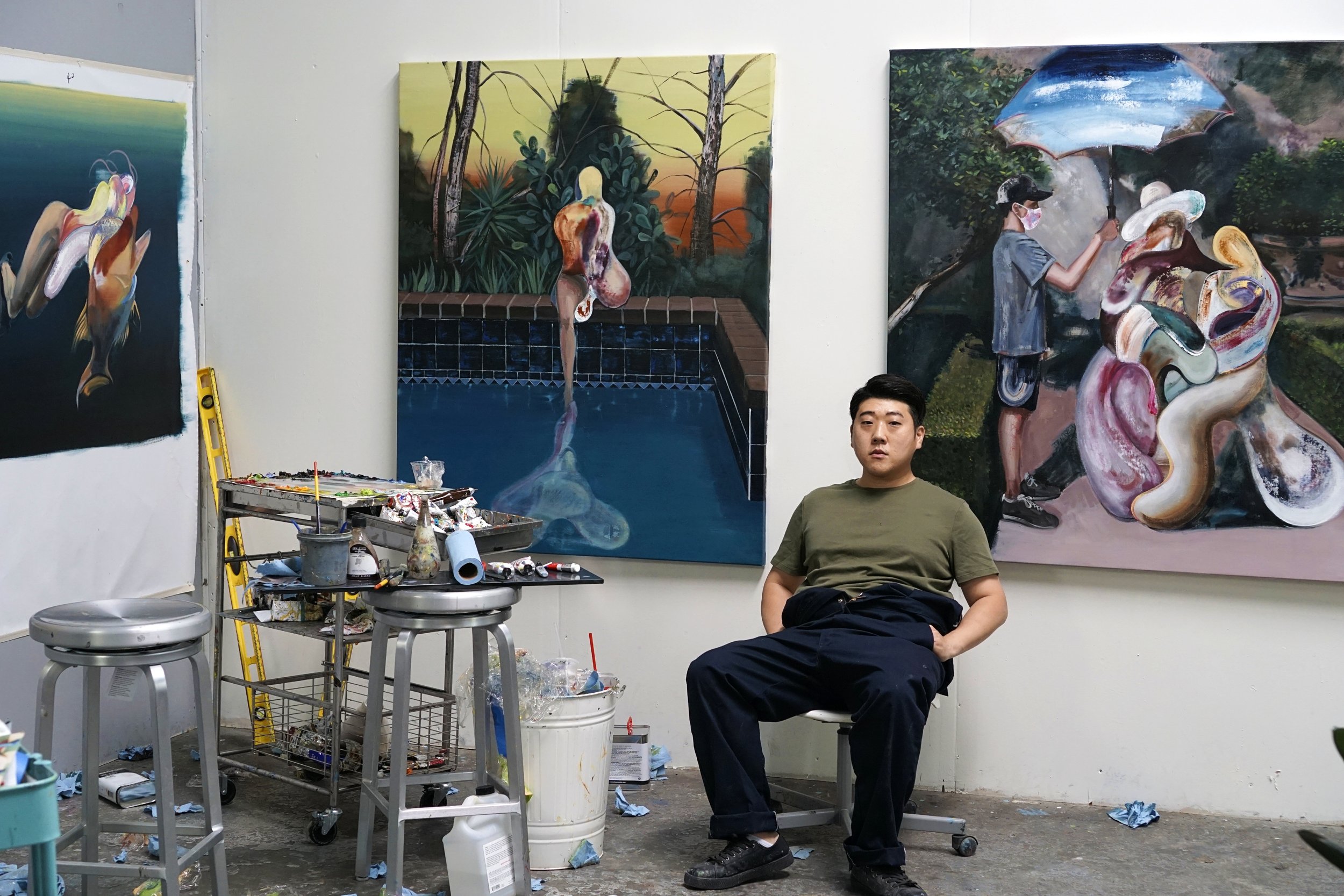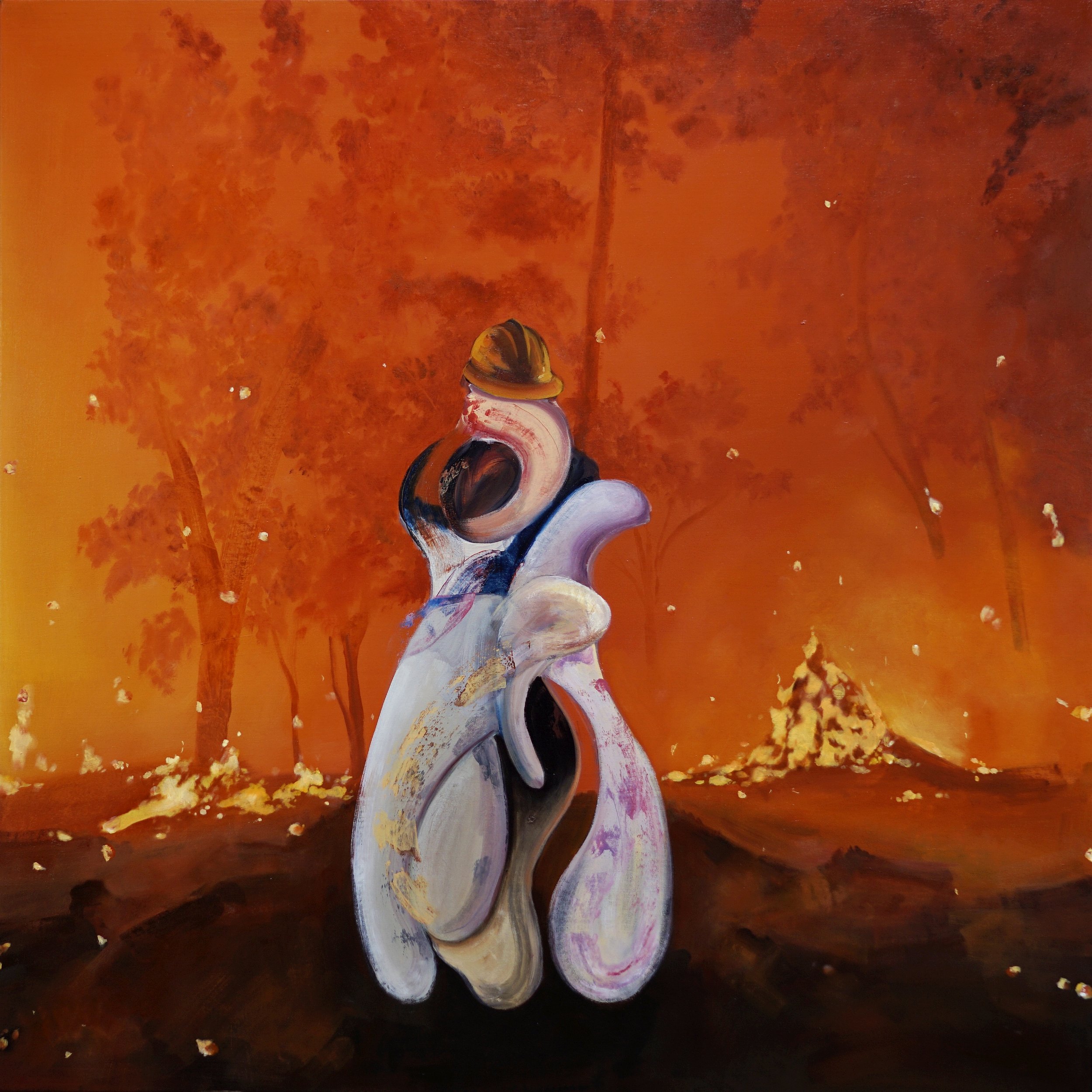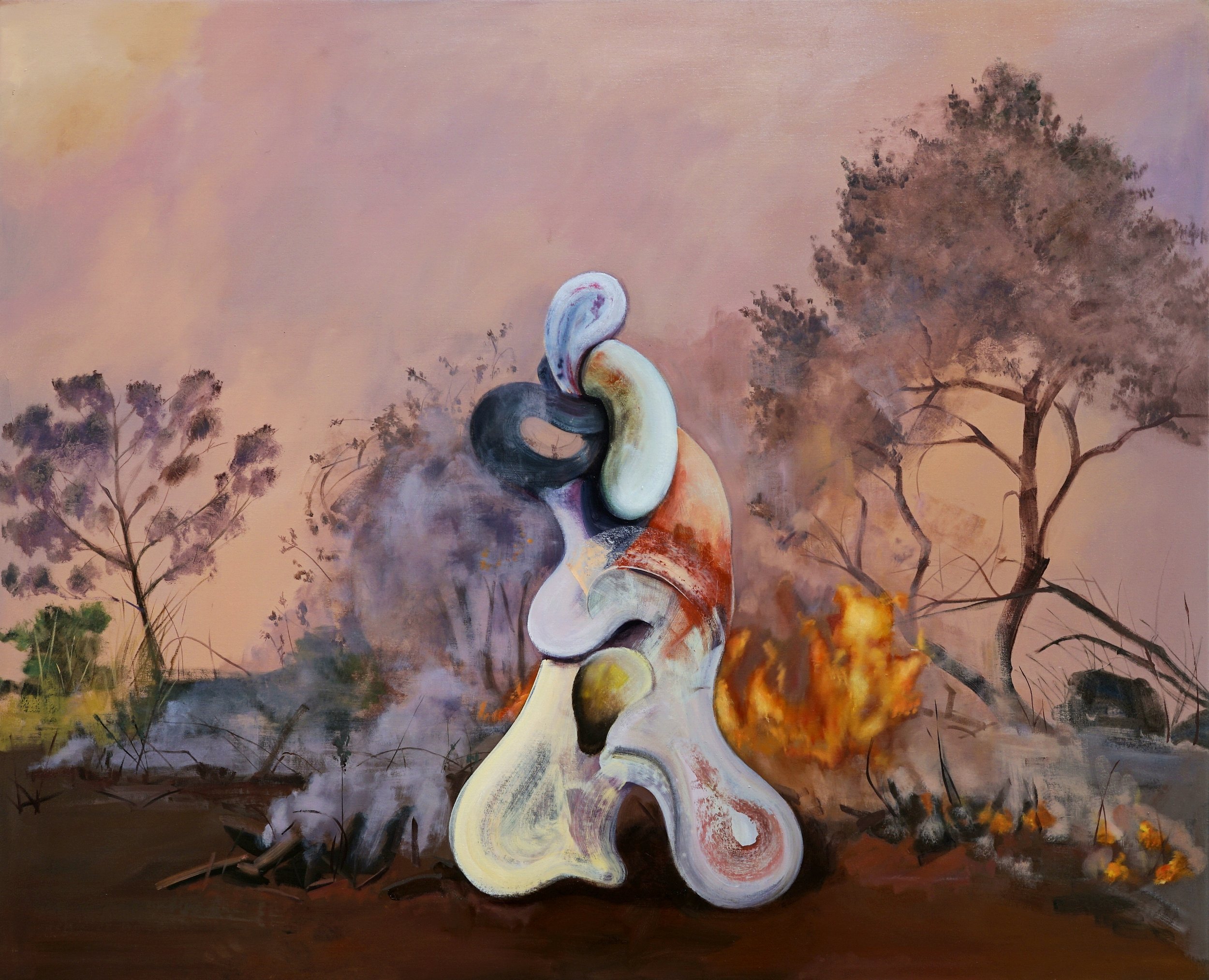
Jay Chung
Jay Chung is a Korean artist, based in Dallas, whose figurative paintings explore the complex interplay of physical realities and interior states of being.
Jay Chung is one of ArtConnect’s Artists to Watch '24
Jay Chung (b. 1986) grew up in Seoul, Korea. After receiving my BA in Architect Engineering and working several years at an architecture & design firm as an advisor, I came to Boston, BFA to pursue my dream as a visual artist. I received my BFA & BA Psychology degree from Tufts University & School of the Museum of Fine Arts (SMFA) in 2016.
Jay Chung is a Korean artist, based in Dallas, whose figurative paintings explore the complex interplay of physical realities and interior states of being.
In his latest body of work, he takes as his subject the human figure, and eschewing conventional representation, seeks to present an “alternative” which expresses “our conscious and unconscious experience of being in the world.”
What appears on the canvas is often a roiling blur of feeling-made-manifest—set on a ground or suspended in space—representing dreamlike states and the imagined contents of our “psychological, societal, and imaginative” lives.
ArtConnect asked the winning artists to share with us a glimpse into their creative life to get a sense of their personal inspiration and artistic process.
How would you describe your artistic style and what inspires your work?
For five years, I have traveled to refugee camps throughout the world. In each country, the same extreme conditions have forced a new perspective in how I see the human condition and, ultimately, how I reflect on my artwork.
Recently my work ruminates on how we can visualize human will and our aspirations and effectively present them.
My processes for creating these series of pieces is embodied in meditation, deep rest, focused thought, and integration of quantum mechanics and the resonance of the physicality of our bodies.
“Jay Chung's work explores the subconscious through dream-like imagery and unconventional subject-object juxtaposition, focusing on their visceral and emotive qualities. By using distorted and disfigured human figures, he challenges traditional notions of reality and delves into the human condition and raw emotions. His style finds inspiration in the emotional surrealism of Francis Bacon, while the contrast with the dismantled bodies creates an emotional juxtaposition with the figurative background.”
Could you share a memorable anecdote or story from your artistic journey that has had a lasting impact on you?
During my travels through challenging environments in multiple countries, I bore witness to their anger, despair, and suffering, and many of their stories have remained indelibly etched in my memory.
Among the countless experiences, a few individuals I met in refugee camps had a profound influence on my life, artistic endeavors, and creations. They overcame the shadows within themselves and shared narratives about the beauty of their lives and the world.
“In the end, they seemed like transcendent beings, and it was through these experiences that I found myself exploring the 'Aesthetics of White Shadows' in my work.”
What emotions or messages do you hope to convey through your work, and why are they important to you?
Let's dive deeper into the essence of our existence. Humans are like vibrations, constantly resonating and responding to the echoes and reverberations around us. Every interaction with life sends seismic waves, creating a tidal rhythm that shapes our experiences.
Life follows a cycle, and my figurative paintings embrace this unconventional representation of the human body, offering a visceral insight into our conscious and unconscious existence. There is a profound connection between the physical and the cerebral. Society, imagination, and dreams serve as a canvas to illustrate the contrast between the tangible and intangible.
My Reverberation series draws inspiration from the philosophical musings of Maurice Merleau-Ponty, particularly his exploration of dualistic thinking and dichotomies in "The Visible and the Invisible." Similarly, my work delves into the human form, incorporating ideas from contemporary physics to unveil the inherent uncertainty in our perception of the human condition, tight spaces, and the interplay of objects.
This uncertainty sheds light on how we unconsciously navigate through spaces we deem reliable and interact with everyday objects. Thus, the subject of the human form intertwines with the quest to understand the void within spaces. Ultimately, my art explores how we interact with and perseveres through isolation.
Can you talk about a specific piece or series that holds a special significance to you?
"Reverberation" is a series created during the pandemic era. It was a series born during what I personally consider one of the most challenging times of my life. Remarkably, all 11 pieces in the series found collectors within just two months, making it a standout and highly influential series in my artistic career.
What does it aim to touch on?
The start of the pandemic saw two of my close friends take their own lives. The suffering of those around me guided me to ponder the effect isolation can have. As a result, I found a new perspective regarding isolation and explored new possibilities through that lens. The "Reverberation" series is my interpretation of isolation and awakening human potential.
Can you describe your creative process and the themes or concepts that drive your work?
My work focuses on a challenge to create figurative paintings which defy a conventional representation of the body and present an alternative that is much more about our conscious and unconscious experience of being in the world. This embodiment references the relationship between our own physicality and our cerebral, societal and imaginative life, foregrounding altered states such as dreaming.
It’s essential to me to contrast this intangible scenario with our inevitable, visceral experience of the world. In this respect, the series Reverberation draws on ideas from The Visible and the Invisible, an unfinished manuscript, and working notes from the French phenomenological philosopher Maurice Merleau-Ponty (1908-61). This text, incomplete at his death, extended his previous works to analyze subject/object dichotomies and dualistic thinking, pursuing a new understanding of the human being as a world and sitting philosophy back within the body.
My compositions focus on the human form, often unrecognizable as if affected by the skewed and invisible forces of contemporary physics, revealing the lack of certainty in what we perceive as conventionally reliable spaces and interrelations of objects. The body-subject is therefore present in my works in parallel with a quest to see the space of nothing, a process that Merleau-Ponty posited as a way to find alternative thought and meaning. This gives a route to resist the predominant consumerist, scientific civilization and find contrasting approaches.
How do you stay motivated and inspired in your artistic practice?
Inspiration finds me through a multitude of sources, including people's stories, films, documentaries, and my extensive travels to socially isolated, unprotected, or abandoned regions worldwide. and through conversations and experiences with many individuals in such places that I draw inspiration. However, during the pandemic, as travel became increasingly challenging, I occasionally sought solace in camping amidst the serene forests, embracing solitude and meditation as sources of inspiration.
How do you balance your artistic career with the business aspect of being an artist?
In my artistic practice, I emphasize preserving and harnessing the aesthetic perspective that art uniquely possesses. This perspective allows me to delve into the intricacies of form, composition, color, texture, and other visual elements that contribute to a piece's overall beauty and impact.
However, not merely pursuing visual allure drives my creative process. The true artistic depth lies in striking a delicate equilibrium between the work's contextual and visual aspects.
How do you see the role of contemporary art in today's society, and how do you see your work contributing to this?
As an abstract painter, my primary exploration revolves around the contemporary state of our world and the diversity of cultures. I emphasize the resilience of individuals from around the world who exhibit unwavering determination in the face of the harsh environments they call home, environments often rejected by society and culture. I have observed people battling their anxieties, setbacks, and anger during life's most challenging moments. This continuous observation leads me to question how one can find oneself within the world, what relevance it holds in the human condition, and how these experiences can bring change and fresh perspectives to the lives of others.
Reflecting on my own experiences and the way I perceive and portray the world, I have been confronted with increasingly profound questions surrounding art. What is art? What does it mean to create a painting? How can one find a balance between visualization and context? How do my works fit into the global conversation and the timeline of art within our civilization?" Art is an additional window through which we can perceive aspects of our world that may have previously gone unnoticed or intentionally ignored. It can shed light on hidden truths and offer fresh perspectives on societal issues.
Art is not created in isolation; it emerges from the very fabric of the present in which we exist. It carries the essence of our times—the characteristics, changes, and events that shape our collective experiences. Through artistic expression, we find a medium to convey the realities we face, not through written or spoken words, but through the language of art itself. In its unique form, art becomes a platform for communication, allowing us to engage with the challenges and triumphs of our era. Artists are fighters, worriers, and comforters, each in their way. They channel their emotions and observations into their work, using words, gestures, and expressions to convey a message surpassing verbal communication's limitations. Art should never remain silent; it must have a voice that resonates with the times and speaks to the human condition.
When art embraces its role in society and fearlessly reflects the realities we navigate, it becomes all the more valuable. In a world where we constantly strive for progress, art catalyzes change. It provokes critical thinking, challenges societal norms, and encourages dialogue. It can ignite empathy, inspire action, and foster a deeper understanding among individuals. By holding up a mirror to our society, art compels us to confront uncomfortable truths and prompts us to work towards a more compassionate and inclusive world.. Art can bridge divides, break down barriers, and bring people together. It unites us in our shared humanity, reminding us of our interconnectedness. It prompts us to reflect, question, and imagine alternative possibilities.
As artists, it is our responsibility to embrace this role and use our creative voices to contribute to the ongoing conversation of our time. In essence, art is a powerful force that shapes and reflects society. It is not a passive bystander but an active participant in the evolution of our collective consciousness. It can influence minds, challenge perceptions, and ignite change. As we engage with art, we are invited to see, feel, and reflect upon our world in ways that can be transformative. Let us cherish and celebrate the role of art, ensuring that it continues to speak boldly and authentically within our society.
See more of Jay’s work






